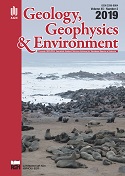The magnetic response of hydrothermal alteration in iron-oxide basement complex, NW Nigeria
DOI:
https://doi.org/10.7494/geol.2019.45.2.145Keywords:
alteration mapping, remote sensing, shear zone, aeromagnetic dataAbstract
Aeromagnetic data was processed in order to delineate structural trends which may be indicative of potential gold mineral traps in the Watari hill gold prospect located between longitude 5°8''and 5°16'', and latitude 11°24'' and 11°30'' in Garin Hawal district, northwest Nigeria. Landsat-8 OLI data was processed to produce colour composite, band ratio and minimum noise fraction images that mapped the hydrothermal alteration zone in the study area. The multispectral images which were displayed in Red-Green-Blue colours were subsequently pan-sharpened to display a greater image resolution of the area. The application of enhancement algorithms such as an analytic signal to the aeromagnetic data over the alteration zone helped in mapping the mafic metavolcanics, felsic metasediments and intruding granitoid complexes. Further reductions using the second vertical derivative and tilt angle derivative filters aided in delineating fracture/faults and the contact zones of the formations, especially the metasediments-metavolcanic boundary that delineates the shear zone. This study showed that the low-angle geologic structure between the metasediments and metavolcanics where hydrothermal alteration is present is likely to accommodate veins of gold mineralization in the study area.Downloads
References
Crosta A. & De Souza Filho C., 2009. Mineral exploration with Landsat Thematic Mapper (TM) / Enhanced Thematic Mapper plus (ETM+): A review of fundamentals, characteristics, data processing, and case studies. Review in Economic Geology, 16, 59–82.
Crosta A. & Rabelo A., 1993. Assessing of Landsat TM for hydrothermal alteration mapping in central western Brazil. [in:] Proceedings of the Ninth Thematic Conference on Geologic Remote Sensing: Exploration, Engineering, and Environment: 8–11 February 1993, Pasadena, California, USA, Environmental Research Institute of Michigan, 53–61.
Dentith M. & Mudge S.T., 2014. Geophysics for the Mineral Exploration Geoscientist. Cambridge University Press, Cambridge, United Kingdom.
Furon R., 1963. Geology of Africa. Oliver and Boyd.
Green A.A., Berman M., Switzer P. & Craig M.D., 1988. A transformation for ordering multispectral data in terms of image quality with implications for noise removal. Geoscience and Remote Sensing, 26, 1, 65–74.
Gunn P.J. & Dentith M.C., 1997. Magnetic responses associated with mineral deposits. ASGO Journal of Australian Geology and Geophysics, 17, 2, 145–158.
Hunt G.R. & Ashley P., 1979. Spectra of altered rocks in the visible and near infraraed. Economic Geology, 74, 1613–1629.
Kogbe C., 1979. Geology of the south-eastern sector of the Iullemmeden Basin. Bulletin of Department of Geology, Ahmadu Bello University, Zaria, 2, 1, 44–63.
Mackay L., 2005. Earth observation and GIS of the physical environment. Lecture series 4 – School of Geography, University of Leeds, United Kingdom, [on-line:] https://www.coursehero.com/file/22033398/Lecture4 [access: 10.05.2019].
Pour A.B. & Hashim M., 2014. Hydrothermal alteration mapping using Landsat-8 data, Sar Cheshmeh copper mining district, SE Iran. Journal of Taibah University for Science, 9, 155 –166.
Ramadan T.M. & Mohammed F.A., 2011. Characteristics of gold mineralization in Garin Hawal area, Kebbi State, NW Nigeria, using remote sensing. The Egyptian Journal of Remote Sensing and Space Science,13, 153–163.
Sabins F., 1999. Remote sensing for mineral exploration. Ore Geology Review, 14, 157–183.
USGS, 2015. Landsat-8 (L8) Data Users Handbook. Version 1.0.
Wright J.B., Hastings D.A. & William H.R., 1985. Geology and mineral resources of West Africa. Allen and Unwin, London.
Downloads
Published
Issue
Section
License
Authors have full copyright and property rights to their work. Their copyrights to store the work, duplicate it in printing (as well as in the form of a digital CD recording), to make it available in the digital form, on the Internet and putting into circulation multiplied copies of the work worldwide are unlimited.
The content of the journal is freely available according to the Creative Commons License Attribution 4.0 International (CC BY 4.0)










